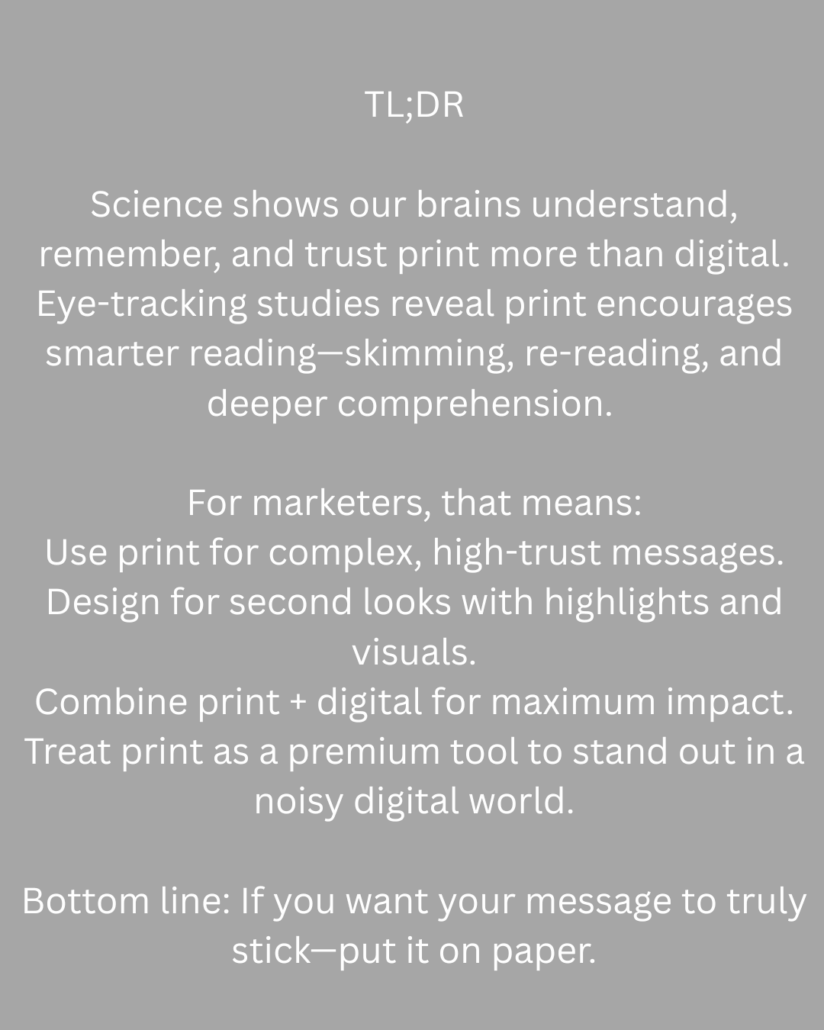Why Your Brain Loves Print – And What This Means for Smart Marketers
Have you ever noticed something strange? When you need to really understand something important—like studying for a big test or reading a complicated contract—you probably prefer reading it on paper instead of your phone or computer.
You’re not alone. Scientists have been studying this for years, and they’ve discovered something fascinating: our brains actually work better when we read printed words instead of digital ones.
This isn’t just about personal preference. For businesses trying to reach customers, this discovery changes everything.
The Science is Clear: Print Wins
Researchers have run dozens of studies comparing how well people understand what they read on paper versus on screens.

Here’s what they found:
Students learn better from paper. A major study looked at 54 different research projects involving over 171,000 people. The result? People understood information better when they read it on paper instead of digital devices.
Our brains react differently to physical materials. The U.S. Postal Service teamed up with Temple University to study people’s brains while they looked at ads. Using special brain-scanning technology, they discovered that physical ads created stronger emotional responses and were remembered better than digital ads.
People trust print more. When researchers asked thousands of consumers around the world, 65% said they gained a deeper understanding when reading print compared to digital content. They also trusted printed news stories more than social media posts.

The Eye-Tracking Discovery
Here’s where it gets really interesting. A researcher named Yu-Cin Jian wanted to understand why print works better. So she did something clever: she tracked people’s eyes while they read.
Jian had 50 college students read the same six-page Popular Science article—some on paper, others on tablets. Then she watched exactly where their eyes went and how they moved while reading.
The results were eye-opening:
- Same time, different behavior: Both groups spent about the same total time reading
- Better understanding with print: Students who read on paper scored higher on comprehension tests
- Different reading patterns: Digital readers mostly read straight through once. Print readers skimmed first, then went back to re-read the most important parts
That last point is huge. Print naturally makes us read in a smarter way—we scan, think, and return to what matters most.
Why Print Has This Power
Scientists have figured out several reasons why our brains prefer print:
Physical clues help memory. When you hold a real book or paper, you can feel where you are—how thick the pages are, where exactly you read something. These physical sensations help your brain remember better.
Less mental overload. Screens can overwhelm our brains. There are notifications, hyperlinks, and the temptation to multitask. Even when we resist these distractions, our brains use energy just avoiding them.
Natural breaks help thinking. Print naturally breaks information into pages and sections. This helps our brains process information in manageable chunks instead of one endless scroll.
Re-reading happens naturally. As Jian’s study showed, people naturally revisit important parts when reading print. This repetition helps ideas stick.
What This Means for Marketers
If you’re trying to reach customers, this research isn’t just interesting—it’s useful. Here’s how smart marketers can use these insights:
- Use Print for Complex Messages
When you need people to really understand something (not just glance at it), choose print. This works especially well for:
- Insurance explanations
- Investment advice
- Technical product details
- Fundraising appeals
Digital gets attention fast. Print makes it stick.
- Design for Second Looks
Since people re-read print materials, make the most of it. Use:
- Highlighted quotes that catch the eye
- Clear bullet points
- Eye-catching graphics
- Important facts in boxes
Remember: these elements often get read multiple times, multiplying their impact.


- Combine Print and Digital
The smartest approach isn’t choosing one or the other—it’s using both together. For example:
- Send a printed catalog that drives people to your website
- Follow up digital ads with a mailed brochure
- Use printed materials to build trust, then digital for quick action
- Leverage Print’s Trust Factor
In a world full of “fake news” and digital scams, printed materials feel more trustworthy. People naturally view print as more credible than digital ads. This makes print perfect for:
- Building your company’s reputation
- Establishing expertise
- Creating premium brand perception
Real-World Examples
Retail stores that send printed catalogs find customers use them differently than websites—they browse, plan, and visualize purchases in ways digital can’t match.
Banks discover that customers better understand and follow important financial information when it’s mailed in print rather than emailed.
Nonprofits still raise most of their donations through printed mail because donors process and respond to physical appeals more readily than emails.

The Future: Print as Premium
This doesn’t mean digital is going away. Digital is still the king for speed, reach, and interaction. But smart marketers who rely only on digital are missing out on deeper understanding, trust, and lasting impact.
As marketing budgets get tighter, many companies cut print spending first. The science says that’s a mistake. Instead, think of print as your premium tool—use it strategically when your message needs to be truly understood and remembered.
In a world flooded with digital noise, a well-designed printed piece actually stands out more than ever. It feels special because it’s becoming rare.
What You Should Do
The brain science is crystal clear: print processes information differently and often more effectively than digital. Here’s your action plan:
✓ Use print when understanding matters – Save it for messages that require comprehension and trust
✓ Design for re-reading – Include clear highlights and visual breaks that reward a second look
✓ Integrate print with digital – Don’t choose sides; use them together for maximum impact
✓ Treat print as premium – It’s not an afterthought but a strategic advantage
Bottom line: When your message absolutely must stick in someone’s mind, put it on paper. Your brain will thank you—and so will your customers.
Want to learn more about using neuroscience in your marketing? The research is clear, but the applications are just beginning. Let us know if you want more information on how to improve your commercial print marketing.




